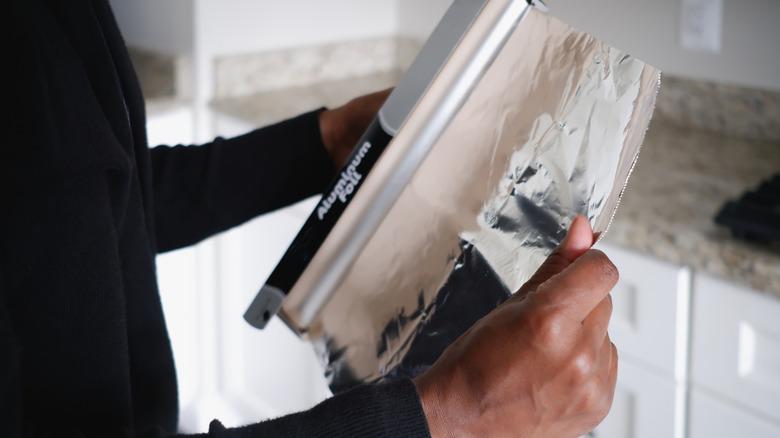Why Do Some People Put Aluminum Foil In Their Toilet?
The internet is filled with home maintenance hacks, and while some (like sneaking extra storage through tricky designs in the house) are harmless and work to improve the space, not all hacks are created equal. Take the "aluminum-foil-in-the-toilet-tank" myth that's circulated on the web as a water-saving tool. While some believe that setting foil balls inside the tank reduces water waste (since some toilets use more water than necessary for it to effectively work), others also believe it can help prevent leaks in the tank by supporting the buoyancy of the flapper valve. Aluminum is also rumored to help stave off mineral deposits and rust. It's no wonder that so many homeowners think it's a benefit for the toilet. However, there are several risks associated with this aluminum foil trick.
Addressing the most famous rumored benefit, the reality is that putting aluminum in your toilet's tank doesn't actually result in notable water savings. Aluminum is too light to make any significant impact on water displacement, thus it doesn't truly offset water usage. Rather, any savings on your water bill will be incredibly nominal, and most likely the trick will be ineffective for the savings that you expected. Some toilet models even specify in their user warnings that placing foreign objects in the tank will void the product's warranty altogether, making the financial harm of this potential hack not worth the projected savings. However, this water-saving myth is only the tip of the iceberg when it comes to the possible damage that aluminum foil can do if placed in toilet tanks in the home.
Other risks to aluminum foil in the toilet tank
Though foil is rumored in these home hack DIYs to support the mechanisms in the tank, you're actually endangering all of the other parts of the toilet with threats of clogging. Foil can break down over time, and pieces migrate into other systems, resulting in clogging at the worst, or, at best, unsightly pieces of foil floating in your bowl. In addition to clogging risks, foil doesn't actually prevent mineral deposits or rust buildup in the toilet either. In fact, there is also little to no scientific study that corroborates that foil itself prevents any such issue. Rather, a scientific study published by Goa University points to the opposite: The aluminum foil is susceptible to corrosion, particularly when exposed for prolonged periods of time to moisture. You can, however, remove rust using foil by dampening a piece of it and scrubbing lightly to work rust away, but any significant contact with water will cause the foil to degrade. The risk you take to hack your toilet tank is ultimately not worth it overall.
While there are plenty of safe foil-related home hacks — after all, foil could be answer to frozen pipes in the winter or even be used to protect drains from grease damage – to achieve water savings in a safe way, opt for a tank insert. Tank inserts are crafted to retrofit toilets to use less water per flush, and can be installed without any heavy tools. If cleanliness and rust prevention are your main concerns, then consider installing a water softener system to decrease minerals and metals in your water supply. Of course, you can use natural methods to clean the toilets as well, like vinegar and baking soda, but at the end of the day, steer clear of foil in the tank.

